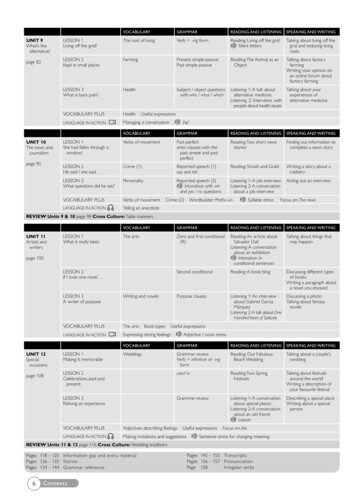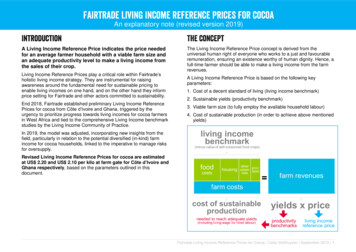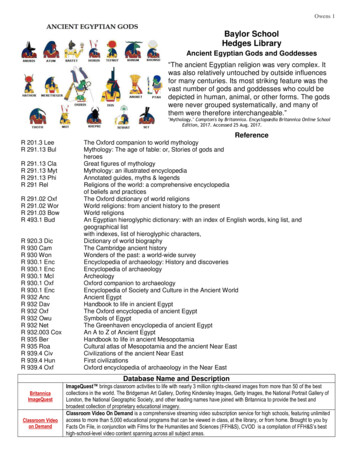
Transcription
Graduate Theses and DissertationsIowa State University Capstones, Theses andDissertations2013Living in a world with eyeballs: How women makemeaning of body image in the college environmentChrystal Ann StanleyIowa State UniversityFollow this and additional works at: https://lib.dr.iastate.edu/etdPart of the Educational Administration and Supervision CommonsRecommended CitationStanley, Chrystal Ann, "Living in a world with eyeballs: How women make meaning of body image in the college environment"(2013). Graduate Theses and Dissertations. 13015.https://lib.dr.iastate.edu/etd/13015This Dissertation is brought to you for free and open access by the Iowa State University Capstones, Theses and Dissertations at Iowa State UniversityDigital Repository. It has been accepted for inclusion in Graduate Theses and Dissertations by an authorized administrator of Iowa State UniversityDigital Repository. For more information, please contact digirep@iastate.edu.www.manaraa.com
Living in a world with eyeballs: How women make meaningof body image in the college environmentbyChrystal Ann StanleyA dissertation submitted to the graduate facultyin partial fulfillment of the requirements for the degree ofDOCTOR OF PHILOSOPHYMajor: Education (Educational Leadership)Program of Study Committee:Larry H. Ebbers, Major ProfessorTyson MarshMarisa RiveraWilliam R. GravesSharon K. DrakeIowa State UniversityAmes, Iowa2013Copyright Chrystal Ann Stanley, 2013. All rights reserved.www.manaraa.com
iiDEDICATIONTo John, Zach, and Morgan:for your patience, faith, and love!www.manaraa.com
iiiTABLE OF CONTENTSLIST OF FIGURESviABSTRACTviiCHAPTER 1. INTRODUCTIONBackgroundStatement of the ProblemPurpose of the StudyResearch QuestionsSignificance of the StudyTheoretical Framework and PerspectiveResearch DesignDefinition of TermsSummary1123334567CHAPTER 2. LITERATURE REVIEWConstructing ImageProtective FactorsCorrelation with Academic Success and Decision MakingFeminist Theory of the BodySexual differenceBody consciousness and regulationSummary1011172025272831CHAPTER 3. METHODOLOGYIntroductionResearch QuestionsCharacteristics of Qualitative ResearchMethodological ApproachInterpretive phenomenological analysis (IPA)ImplementationTheoretical UnderpinningsResearch DesignHuman subjects approvalParticipantsSite selectionResearch methods and data collectionData analysisTrustworthiness and ValidityInternal validityTriangulationMember naraa.com
ivPeer review/debriefingReliabilityAudit trailResearcher role and positionalityExternal validity and generalizabilityThick and rich descriptionEthical APTER 4. ANALYSIS AND FINDINGSData Analysis ProcessBackground of the ParticipantsGraceIsabelleHopeBody ImagePubertyBody projectsThemesRelationships with female relatives and friendsMedia influenceMedia educationCelebrity comparisonParticipation in athleticsRelationships with individuals with 792CHAPTER 5. DISCUSSIONSummary of Research and MethodologyTheoretical framework and perspectiveResearch designData analysis processMethodological DiscoveriesSummary of Findings and Discussion of ThemesRelationships with female relatives and peersMedia influenceParticipation in athleticsRelationships with individuals with disabilitiesStrengths and LimitationsImplications for Policy and PracticeAcademic and co-curricular unitsUniversity counseling centersK-12 www.manaraa.com
vRecommendations for Future ResearchReflexivity116118APPENDIX A. HUMAN SUBJECTS APPROVAL121APPENDIX B. PARTICIPANT COMMUNICATION122APPENDIX C. CELEBRITY COMPARISON EXERCISE128APPENDIX D. BODY IMAGE LITERATURE om
viTABLE OF FIGURESFigure 1. Emerging model of body image making in the college environment99www.manaraa.com
viiABSTRACTNegative body image is pervasive among traditional, college-age women and takes aheavy toll on women‘s economic, personal, and political lives. Previous research hasindicated that a large percentage of women hold negative views of their body. Womenembarking on higher education are not exempt from these negative views. Conversely,college can pose challenges for women as they attempt to negotiate their academic, public,and personal identities.While existing literature has provided insight regarding body-image issues amongtraditional-aged college women, little attention has been focused on the protective factorsinfluencing body image. Addressing dissatisfaction with body image and identifying positiveprotective factors is especially salient for college personnel, given that women of college-agehave been noted to be at high risk for social, physical, and mental health issues associatedwith body image.The purpose of this qualitative study was to explore how young women come tounderstand body image and make meaning of their own body image in the collegeenvironment. This study also examined the role of protective factors in the formation ofyoung women‘s body image. Four themes emerged as influential in the participants‘ lives:relationships with female relatives and peers; media influence; participation in athletics; andrelationships with people with disabilities. A new model was developed in this study toexplain how young women may potentially come to understand their body image and makemeaning of body image in the college environment.www.manaraa.com
1CHAPTER 1. INTRODUCTIONBackgroundNegative self-image takes a heavy toll on women‘s economic, personal, and politicallives; therefore, body image is an important area for research (McKinley & Hyde, 1996). InIn her book, The body project: An intimate history of American girls, Brumberg (1997)posited that a girl‘s body is her ―nemesis‖ (p. xxv). American girls and women areconstantly confronted with traditional concepts of beauty and stereotypes regarding physicalappearance (Miles, 2009). These stereotypes of beauty are perpetuated by media images andsocietal expectations.The continual shifts in cultural norms have cause today‘s women to deal with manyambiguous and contradictory role expectations (Brumberg, 1997; Brylinsky, 1990). Womenare assumed to have the desire to accommodate traditional feminine expectations, such asphysical attractiveness and domesticity, as well as incorporate more modern standards ofpersonal achievement and autonomy (Brylinsky). These changing expectations, and a shift inthe 1960s to an emphasis on thinness for women, have caused increasing dissatisfaction forwomen regarding their bodies and self-image (Brylinksy). Many of these pressures areperpetuated by the media.The standards of beauty and attractiveness set forth by the media may contribute to awoman‘s satisfaction or dissatisfaction with her body. Miles (2009) noted that ― viewingimages of the thin-ideal caused an increase in body dissatisfaction, negative mood states, andeating disorder symptoms‖ (p. 5). Viewing these images also led to decreased self-esteem(Miles). According to Miles, women react to media imaging in one of two ways: theywww.manaraa.com
2attempt to achieve the ideal standard of beauty, or they see the ideal as unattainable andchoose to abandon a healthy lifestyle completely.Surveys of women conducted by Sanftner, Ryan, and Pierce (2009) indicated thatmore than half (56%) hold negative views of their body. Women embarking on highereducation are not exempt from these negative views. Conversely, college can pose specific― challenges not only to academic identity, but also to fundamental personal aspects of self‖(Knightly & Whitelock, 2007). A woman‘s experience in college is a paradox betweenintellectual pursuits and the pull to conform to society‘s expectations (Miles, 2009). Becauseof this paradox, negative body image is common among traditional college-age women, yetnot all women are impacted by these negative views. This dichotomy has led a limitednumber of researchers to investigate protective factors—such as feminist identity, resilience,and empowerment—to determine the association of these variables with body-imageperception (Sanftner et al., 2009).Statement of the ProblemNegative body image is pervasive among traditional, college-age women and takes aheavy toll on women‘s economic, personal, and political lives (McKinley & Hyde, 1996).Women internalize cultural body standards and, as a result, learn to associate the body withself-love, health, and individual achievement (McKinley & Hyde, 1996; Peterson, Grippo, &Tantleff-Dunn, 2008). These women are at risk to develop eating disorders and othernegative behaviors as they are faced with pressure to perform both socially and academically(Baugh, Mullis, Mullis, Hicks, & Peterson, 2010). While existing literature has providedinsight into body image among traditional-aged college women, little attention has beenwww.manaraa.com
3focused on the protective factors influencing body image. Addressing dissatisfaction withbody image and identifying positive protective factors is especially salient for collegepersonnel, given that women of college-age are perceived to be at high risk for social,physical and mental health issues associated with body image (McGrath, Wiggin & Caron,2010).Purpose of the StudyThe purpose of this qualitative study was to explore how young women come tounderstand body image and make meaning of their own body image. This study alsoexamined the role of protective factors in the formation of young women‘s body image.Research QuestionsThe following research questions framed this study:1. How do college women come to understand body image?2. How do college women make meaning of their own body image in the collegeenvironment?Significance of the StudyThe results of this study are intended to add to the growing body of research in theareas of psychology, sociology, education, and women‘s studies regarding body image intraditional college-age women. The intent was to examine the relationship among bodyimage perception, protective factors, and the college experience. Understanding how collegewomen come to understand body image and the influence of body-image perception is aworthy endeavor, especially when considering the impact of negative body image on awoman‘s physical, mental and emotional well-being.www.manaraa.com
4The results of this study may potentially influence the practices of college officesdealing with young women who may have a dissatisfied body image. While a large amountof research has been conducted regarding body image, the majority has been quantitative.This has provided college administrators with valuable aggregate data regarding the impactof negative body image; however, answers to the ―why‖ and ―how‖ questions are uncertain.Therefore, administrators might be missing vital information that could assist with policydevelopment and practice. This study attempted to give voice to the ―why‖ and ―how‖surrounding body image. By using newly identified voices, it is hoped that new meaningcould be given to old practices, and new practices and policies might be identified. Thefindings of this study may also spur additional qualitative research in the area of body imageand its meaning for college women, especially as it relates to media influence. Additionally,the findings may lead to a study of the relationship between body image and participation inathletics as well as relationships with individuals with disabilities.Theoretical Framework and PerspectiveThis interpretive phenomenological study incorporated a constructionistepistemology; the premise was that young women and girls construct their reality based upontheir interactions with society (Crotty, 1998). Interpretive phenomenological analysis (IPA)is well suited for researching issues surrounding body image as IPA particularly addresseshow individuals make sense of their major life experiences (Smith, Flower, & Larkin, 2009).By employing IPA methods as the researcher, I interpreted what participants told me abouttheir lived experiences as they attempted to make sense of them.www.manaraa.com
5A feminist theoretical perspective was used to guide the research and analyze data. Iselected this prospective to understand how young women interpret the meaning of the worldaround them and determine a sense of self and body image, specifically through theirinteractions with others. Feminist social science identifies five common concepts (Bloom,1998). The first concept is the social construction of gender, realizing that narratives areconstructed by the individual and are also socially constructed. Second, feminist theory canbe used to explore the tensions and contradictions of women‘s diverse lives and theirpersonal narratives including methods for interpreting and deconstructing narrative data.Third, the importance of the context of the research question can be demonstrated throughreports of conflict that provide interesting insights for locating subjectivity and understandinghow it is fragmented. Next, carefully and thoughtfully crafted prose exposing the criticalself-reflection of the researcher is shared while exposing how the researcher‘s biographyinfluences interpretation. Finally, the researcher-participant relationship is paramount toconvey the realities of feminist research (Bloom, 1998).Feminist theory provided a lens through which to situate this study. However, as datawere analyzed, additional theories were explored to understand the findings.Research DesignThis qualitative, interpretive phenomenological study with a constructionistepistemology used semi-structured in-depth interviews. Three interviews were scheduledwith specific, guiding questions and topics for which participants were encouraged toelaborate. The first interview focused on life history, the second on details of the experience,www.manaraa.com
6and the final on reflection on meaning (Seidman, 2006). This enabled each participant‘sperspective on body image to be articulated and uncovered as the individual experienced it.Data analysis was conducted using a multi-phased approach (Creswell, 2002;Esterberg, 2002; Merriam, 2002). First, I began content analysis by organizing and preparingmy data (Creswell, 2009). Transcriptions of interviews were divided into meaning units tomake analysis and theme-development easier (Merriam, 2002). Open coding was used,conducting a line-by-line analysis of the interview transcripts and observation notes(Esterberg, 2002).Similarities and patterns were analyzed, keeping in mind the study‘s epistemologyand theoretical and philosophical underpinnings. From these patterns, themes were identified(Esterberg, 2002). Themes, patterns, and similarities were shared with participants formember-checking, debriefing and feedback in order to ensure the goodness of my research(Creswell, 2009). Transcripts and field notes were reviewed to complete focused coding(Esterberg, 2002). The focused coding primarily honed relevant phenomena, examples ofeach phenomenon, and commonalities among the different data sources (Creswell, 2009).Definition of TermsThe following terms were defined for use in this research:Abstraction: ―Abstraction is a basic form of identifying patterns between emergent themesand developing a sense of what can be called a ‗super-ordinate‘ theme. It involves puttinglike with like and developing a new name for the cluster (Smith, Flowers, & Larkin, 2009,pp. 96-97).www.manaraa.com
7Body Image: First defined as the picture of our body that we form in our minds (Brylinsky,1990). This definition was later refined to include the degree to which we are satisfied withthat picture. Priya, Prasanna, Sucharitha, and Vaz (2010) defined body image as ―the mentalpicture we have of our body‘s measures, contours and shape; and our feelings related to thesecharacteristics and to our body parts‖ (p. 316). It is this later definition that is used in thisstudy.Self-Image: Has been defined by psychologist in several ways. The most common definitionstates that self-image is the ― total subjective perception of oneself, including an image ofone‘s body and impressions of one's personality, capabilities, and so on‖ (Coon, 1994, 471).Self-image is often closely tied to self-concept which has been defined as ―ones self-identity,a schema, consisting of an organized collection of beliefs and feelings about oneself‖ (Baron& Byme, 1997, 152) and as ―a cognitive appraisal of our physical, social, and academiccompetence‖ (Eggen & Kauchak, 1999, 79). While these terms are often usedinterchangeably, for the purpose of this study, self-image will be defined using the definitionfrom Coon (1994).Subsumption: ― is similar to abstraction but it operates where an emergent theme itselfacquires a super-ordinate status as it helps bring together a series of related themes‖ (Smith,Flowers & Larkin, 2009, pp. 96-97).SummaryThis study explored the experiences of college women with body image and how theymake meaning of their own body image. The findings of the study may help informadministrators and policy makers in institutions of higher education regarding the impact ofwww.manaraa.com
8negative body image on young women and will, hopefully, influence the practice of collegeoffices dealing with young women who may have dissatisfied body image.Chapter 2 contains a literature review, which provides the definition of body imageand outlines the way in which women construct body image. It presents and discussesliterature regarding potential protective factors, the correlation of body image with decisionmaking, and potential intervention strategies. The chapter is concluded with literature thatintroduces, outlines, and defines feminist theory of the body.Chapter 3, presents the methodology of the study, and includes the characteristics ofqualitative research, implementation of interpretive phenomenological analysis, and feministtheoretical underpinnings. The research design, trustworthiness, and the role andpositionality of researcher are discussed in detail. The chapter concludes with a discussion ofethical issues, delimitations, and potential limitations of the study.Chapter 4 includes participant profiles, their views regarding body image, and adetailed discussion of findings. Findings are organized around major themes identifiedduring the study. Major themes include relationships with female relatives, media influence,relationships with individuals with disabilities, and the impact of participation in athletics onbody image. These themes emerged from interviews conducted with each participant as wellas a review of archival and survey data.The final chapter focuses on a discussion of research findings and the implications ofthose findings. The chapter includes: (a) a brief summary of my research andmethodological approach; (b) a review of discoveries that led to changes or clarifications inmy research approach; (c) a discussion of research findings and how those findings aided inanswering my original research questions; (d) a presentation of implications for policy andwww.manaraa.com
9practice within higher education and student affairs; (e) an overview of how this researchstudy contributes to existing literature and implications for further research; and (f) mypersonal reflections on the research process and experience and its implications on my futureresearch.www.manaraa.com
10CHAPTER 2. REVIEW OF LITERATUREBody image was first defined as the picture of our body that we form in our minds(Brylinsky, 1990). This definition was later refined to include the degree to which we aresatisfied with that picture. Priya, Prasanna, Sucharitha, and Vaz (2010) defined body imageas ―the mental picture we have of our body‘s measures, contours and shape; and our feelingsrelated to these characteristics and to our body parts‖ (p. 316). Fallon (1990) enhanced thedefinition of body image by including the way individuals believe others see them. The issueof dissatisfaction with one‘s body image has been well documented. This dissatisfaction hasbeen defined as a discrepancy between reality and the ideal (Ogden, 2004). Considering theidea of discrepancy, Ogden posited that body dissatisfaction can be assessed in three ways:(1) perceiving the body as larger than it is; (2) discrepancies between how individuals wantto look and how they perceive themselves; and (3) negative feelings about one‘s body.Others have proposed that negative body image is equally influenced by the way individualsbelieve others see them (Fallon, 1990).The literature has revealed that, in the United States, both men and women have adistorted perception of body image. Despite the fact that both sexes have distorted views oftheir body, men and women appear to attach different meanings to their bodies. Brylinsky(1990) suggested that men view their bodies primarily as functional tools that need to be inshape and ready to use. On the other hand, women see their bodies as ―commodities, theirphysical appearance serving as an interpersonal currency‖ (p. 17). Feminist theorists haveindicated that a woman‘s body is constructed to be looked upon as an object; because of this,www.manaraa.com
11women learn to view their bodies as outside observers (McKinley & Hyde, 1996). ―Theyinternalize cultural body standards so that the standards appear to originate from the self andbelieve that achieving these standards is possible, even in the face of considerable evidenceto the contrary‖ (pp. 182-183). Due to this inventory-type view of their bodies as acommodity, women are at a greater risk to develop negative body image, tying their selfworth to their physical appearance (Peterson, Grippo, & Tantleff-Dunn, 2008).Self-objectification is also tied to depressed mood, decreased self-esteem, and evendisruption in performance due to the disruption of focused attention (Peterson et al., 2008).Some believe that college-age women are especially vulnerable because of the transitions andchanges that are occurring in their lives (Miles, 2009). Others have suggested that youngwomen entering college are impacted by social norms associated with appearance that havebeen engrained through idealized images of attractiveness long before they enter college(McGrath, Wiggin, & Caron, 2010). Addressing dissatisfaction with body image andidentifying positive and protective factors is especially salient for college personnel, giventhat women of college age are documented to be at high risk for social, physical and mentalhealth issues associated with body image (McGrath et al.). The remainder of this literaturereview addresses body-image issues in college-age women and the implications of theiractions based upon those issues.Constructing Image―Women learn to associate body surveillance with self-love, health, and individualachievement‖ (McKinley &Hyde, 1996, p 183). Surveys of college-age women indicate thatmore than half report having a negative body image (Sanftner, Ryan, & Pierce, 2009). Thesewww.manaraa.com
12women are at risk to develop eating disorders and other negative behaviors as they are facedwith pressure to perform both socially and academically (Baugh, Mullis, Mullis, Hicks, &Peterson, 2010). At times, women feel a loss of control when they are faced with exceptionalpressure to perform. This can lead to an attempt to gain control through restrictive behaviorswith their bodies (Priya et al., 2010). This response to pressure, along with the view of theirbodies as a commodity, leads women to be more likely to perceive themselves as being moreoverweight than they actually are (Baugh et al., 2010). In fact, Brylinsky (1990) posited that,―50 percent to 70 percent of college female students misperceive their weight-relatedappearance, consistently overestimating their body size eighteen percent more often thanmen‖ (p. 2). Additionally, Gillen, and Lefkowitz (2011) noted that the best predictor of bodyimage and self-esteem is the discrepancy between perceptions of an individual‘s own bodysize and the body size individuals believe the other sex sees as ideal. This construct isimportant for college students, as they spend extensive time with peers in academic, social,living, and working environments. When women perceive their actual size does not comparepositively with the ideal size constructed by others, their body image and self-esteem suffer(Gillen & Lefkowitz, 2011). Shame is a common emotion experienced by women with anegative body image. This shame, as experienced by young women, is tied, not only tonegative feelings about their body, but also negative feelings about themselves (McKinley &Hyde, 1996).Although researchers have agreed that body image is an issue among college-agewomen, this distortion appears to be culturally enhanced. Most at risk are middle to upperclass, white, college-educated women in westernized countries (Brylinsky, 1990). Whilewhite women are most at risk, one should not assume that all women of color are safe fromwww.manaraa.com
13the negative effects of body image distortion. Women of color who are socialized andpressured to adhere to the Western ideal of beauty and dress are also negatively influenced(Baugh, et al., 2010; Hesse-Biber, Livingstone, Ramirez, Barko, & Johnson, 2010). Theimplications of cultural influence extend well beyond race and ethnicity. The continual shiftsin cultural norms have caused today‘s women to deal with many ambiguous andcontradictory role expectations (Brumberg, 1997; Brylinsky, 1990). Women are assumed tohave the desire to accommodate traditional feminine expectations, such as physicalattractiveness and domesticity, as well as to incorporate more modern standards of personalachievement and autonomy (Brylinsky). These changing expectations, and a shift in the1960‘s to an emphasis on thinness for women, has caused increasing dissatisfaction forwomen with their bodies and self-image (Brylinksy). Dissatisfaction with body image maynot be due to a misperception of a woman‘s own body size, but instead a focus on anunrealistic ideal size (Gillen & Lefkowitz, 2011). Many of these pressures are perpetuatedby the media. In a study by Swami and Smith (2012), women who were exposed to mediaimages of the thin ideal experienced more negative body image as compared to controlgroups. Although minimal in number, a few studies have concluded that exposure to mediabody ideals have a null effect (Ferguson, Munoz, Contreras, & Velasquez, 2011; Martin &Kennedy, 1993; Thornton & Maurice, 1997) or even decrease body-image dissatisfaction(Cusumano & Thompson, 1997; Durkin & Paxton, 2002). However, the majority of researchsupports the claim that media images of the female ideal negatively impact body image(Swami & Smith, 2012).American women are constantly confronted with traditional concepts of beauty andstereotypes regarding physical appearance (Miles, 2009). These stereotypes of beauty arewww.manaraa.com
14perpetuated by media images and societal expectations. After the turn of the twentiethcentury, ―because of the introduction of many new kinds of cultural mirrors, in motionpictures and popular photography, in mass-market advertising in the women‘s magazines, aswell as on department store counters and in dressing rooms most women and girls began tosubject their face and figure to more consistent scrutiny‖ (Brumberg, 1997, p. 70). Mostmedia sources portray women in stereotypical ways. ―The images have consistently been thesame old clichés‘ the housewives and the glamour girls. Women have constantly beenghettoized into a very limited number of roles‖ (Quindlen, 1978, p. 41); and these roles havebeen commodified and exploited for corporate gain (McLaren & Farhmandpur, 2005).Media sources influence much of life in America, including the image we have ofourselves as individuals and as a society. During the post-war 1950s, advertising becamemore prevalent with the mass production of the television. Advertising in the early 1950smirrored not necessarily what the population was experiencing but the lifestyle that wasdeemed best - family values in suburbia (Centanni, 2011). Centanni posited that advertisingwas used to create an image of the ―safe haven of suburbia amidst social turmoil‖ (p. 1).Americans flocked to the suburbs to pursue this idealized life that overemphasized thenecessity of traditional family values and pointed to progressive jobs for women outside thehome as a destabilizing force (Centanni). Women, who did not fit with the stereotype,struggled with their identity. Advertisers capitalized on this struggle by suggesting that thepurchase of particular items would strengthen the family. Through advertising, companiesknew they could not only sell products but could also shape the consumer‘s image of whoshe is and who she should become (Centanni). Companies reinforced the notion that successas a mother could be purchased. Women faced the impossible task of adhering to allwww.manaraa.com
15previous expectations of women, while simultaneously satisfying new images of womanhood(Katzman & Lee, 1997). The idea that women can be moral, ―good,‖ and pretty by simplybeing clean and purchasing the correct items has created a multi-billion dollar advertisingindustry focused on women, their lifestyle, and their appearance. This focus on appearanceplays a role in the frequently distorted view women have of their bodies.Knowing that women often tie their self-worth to their physical appearance,advertising campaigns began capitalizing physical appearance. The female ideal changesfrequently; and the woman‘s body has become a marketing tool for products aimed at bothmen and women. When young girls do not see themselves portrayed in these idealizedimages, they often engage in body projects to make themselves appear closer to the idealimage (Brumberg, 1997). Even those television shows that profess to challenge
Correlation with Academic Success and Decision Making 20 Feminist Theory of the Body 25 Sexual difference 27 Body consciousness and regulation 28 Summary 31 CHAPTER 3. METHODOLOGY 33 Introduction 33 Research Questions 33 Characteristics of Qualitative Research 33 Methodological Approach 35 .











